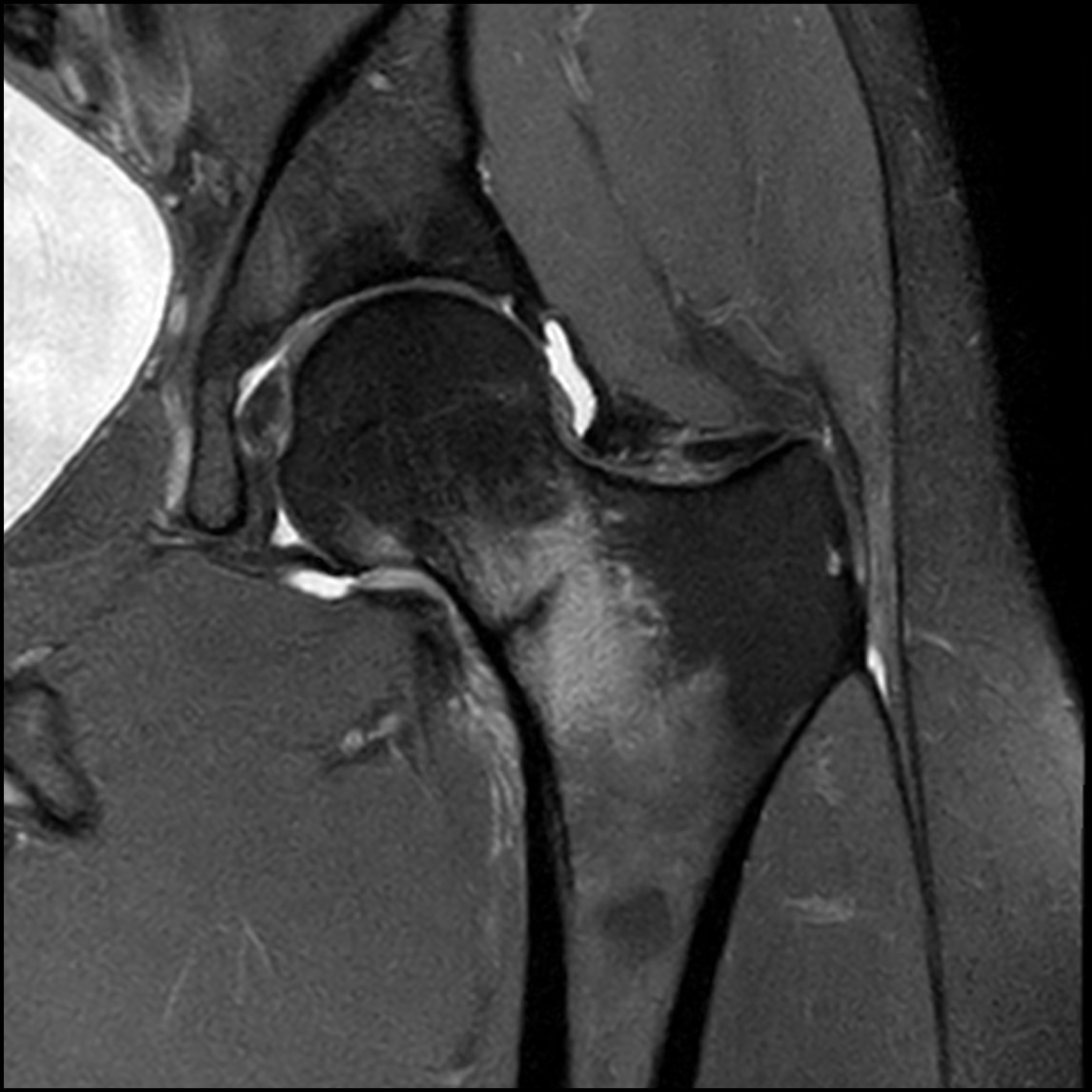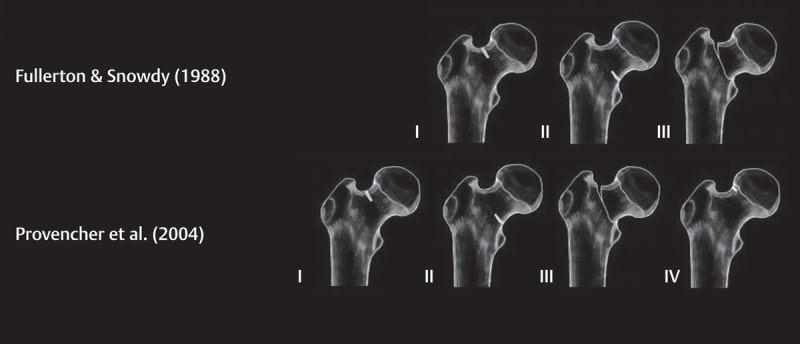Femoral Neck Stress Fracture: Difference between revisions
No edit summary |
mNo edit summary |
||
| (2 intermediate revisions by the same user not shown) | |||
| Line 1: | Line 1: | ||
{{Partial}} | {{Authors | ||
|Authors=Jeremy | |||
}} | |||
{{Condition | |||
|quality=Partial | |||
|image=Femoral-neck-stress-fracture-mri.jpg | |||
|caption=Compression stress fracture of the left femoral head in a 25 year old runner on coronal PD FS | |||
|epidemiology=3% of sport-related stress fractures, most common in female long-distance runners. | |||
|pathophysiology=Fatigue loading of the femoral neck where loading exceeds metabolic repair potential. For tension fractures there is additional component of hip abductor fatigue. | |||
|clinicalfeatures=Exercise induced anterior groin pain, pain at extreme range of motion. | |||
|tests=Plain films, but MRI gold standard. | |||
|treatment=Incomplete compression fractures - conservative. Complete compression, incomplete tension, and displaced - surgical. | |||
|prognosis=Incomplete compression good prognosis. | |||
}} | |||
Femoral neck stress fractures are a rare sport-related stress fracture, most commonly seen in long distance runners. | Femoral neck stress fractures are a rare sport-related stress fracture, most commonly seen in long distance runners. | ||
==Epidemiology== | ==Epidemiology== | ||
It is most commonly seen in female long distance runners with a poor baseline level of fitness. This is due to repetitive submaximal loading in combination with relative energy deficiency.<ref name=":0">{{Special|2}}{{Open access icon}}{{Cite journal|last=Robertson|first=Greg A.|last2=Wood|first2=Alexander M.|date=2017-02|title=Femoral Neck Stress Fractures in Sport: A Current Concepts Review|url=https://pubmed.ncbi.nlm.nih.gov/30539087|journal=Sports Medicine International Open|volume=1|issue=2|pages=E58–E68|doi=10.1055/s-0043-103946|issn=2367-1890|pmc=6226070|pmid=30539087}}</ref> They account for 3% of all sport-related stress fractures. | |||
==Clinical Features == | ==Clinical Features == | ||
| Line 9: | Line 22: | ||
==Classification == | ==Classification == | ||
*Compression sided: infero-medial femoral neck | Originally Fullerton & Snowdy with several modifications: | ||
* | *Type I: Tension sided: supero-lateral femoral neck with vertical fracture line | ||
*Displaced | *Type II: Compression sided: infero-medial femoral neck with oblique fracture line | ||
*Atypical tension | **Further divided into those where fracture line less than 50% of femoral neck width vs greater than 50% | ||
*Type III: Displaced | |||
*Type IV: Atypical superiorly based incomplete tension | |||
[[File:Femoral neck stress fracture classification.jpg]] | |||
==Differential Diagnosis== | ==Differential Diagnosis== | ||
| Line 55: | Line 71: | ||
<references /> | <references /> | ||
{{References}} | |||
{{Reliable sources}} | |||
Latest revision as of 21:46, 5 June 2022
Femoral neck stress fractures are a rare sport-related stress fracture, most commonly seen in long distance runners.
Epidemiology
It is most commonly seen in female long distance runners with a poor baseline level of fitness. This is due to repetitive submaximal loading in combination with relative energy deficiency.[1] They account for 3% of all sport-related stress fractures.
Clinical Features
Patients report a gradual onset poorly localised hip or groin pain that is exacerbated with weight-bearing exercise. The most consistent examination finding is pain at extreme end range of motion, particularly internal rotation.[1]
Classification
Originally Fullerton & Snowdy with several modifications:
- Type I: Tension sided: supero-lateral femoral neck with vertical fracture line
- Type II: Compression sided: infero-medial femoral neck with oblique fracture line
- Further divided into those where fracture line less than 50% of femoral neck width vs greater than 50%
- Type III: Displaced
- Type IV: Atypical superiorly based incomplete tension
Differential Diagnosis
- Femoral Neck Stress Fractures
- Femoral Head Avascular Necrosis
- Hip Labral Tear
- Femoroacetabular Impingement
- Hip Osteoarthritis
- Iliopsoas Tendinopathy
- Rectus Femoris Tendinopathy
- Adductor Tendinopathy
Investigations
Plain films are usually taken first. But quite often MRI is needed for definitive diagnosis.
MRI features include: periosteal oedema and fractur line.
| Grade | Features |
|---|---|
| grade 1 | signals changes only on STIR |
| grade 2 | changes on STIR and T2 |
| grade 3 | changes on STIR, T1, and T2 with no fracture line present |
| grade 4 | changes on STIR, T1, and T2 with a fracture line present |
Treatment
Compression sided fractures are usually treated conservatively with activity modification. Tension sided fractures may need surgery to reduce the risk of fracture completion and osteonecrosis.
References
Papers of particular interest have been highlighted as: ◆ of special interest ◆◆ of outstanding interest
- ↑ 1.0 1.1 ◆◆
 Robertson, Greg A.; Wood, Alexander M. (2017-02). "Femoral Neck Stress Fractures in Sport: A Current Concepts Review". Sports Medicine International Open. 1 (2): E58–E68. doi:10.1055/s-0043-103946. ISSN 2367-1890. PMC 6226070. PMID 30539087. Check date values in:
Robertson, Greg A.; Wood, Alexander M. (2017-02). "Femoral Neck Stress Fractures in Sport: A Current Concepts Review". Sports Medicine International Open. 1 (2): E58–E68. doi:10.1055/s-0043-103946. ISSN 2367-1890. PMC 6226070. PMID 30539087. Check date values in: |date=(help) - ↑ Arendt, E. A.; Griffiths, H. J. (1997-04). "The use of MR imaging in the assessment and clinical management of stress reactions of bone in high-performance athletes". Clinics in Sports Medicine. 16 (2): 291–306. doi:10.1016/s0278-5919(05)70023-5. ISSN 0278-5919. PMID 9238311. Check date values in:
|date=(help)
Literature Review
- Reviews from the last 7 years: review articles, free review articles, systematic reviews, meta-analyses, NCBI Bookshelf
- Articles from all years: PubMed search, Google Scholar search.
- TRIP Database: clinical publications about evidence-based medicine.
- Other Wikis: Radiopaedia, Wikipedia Search, Wikipedia I Feel Lucky, Orthobullets,




